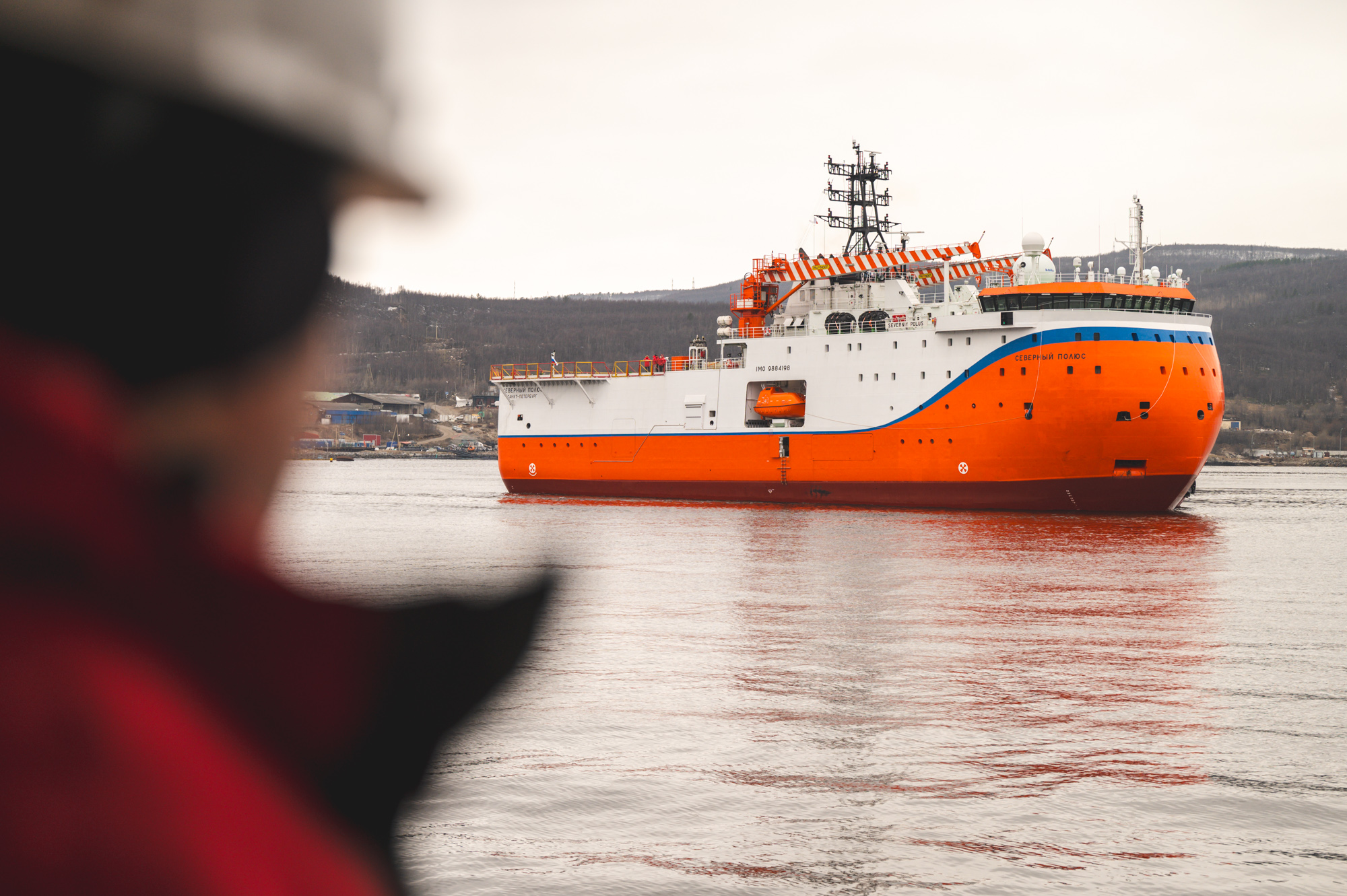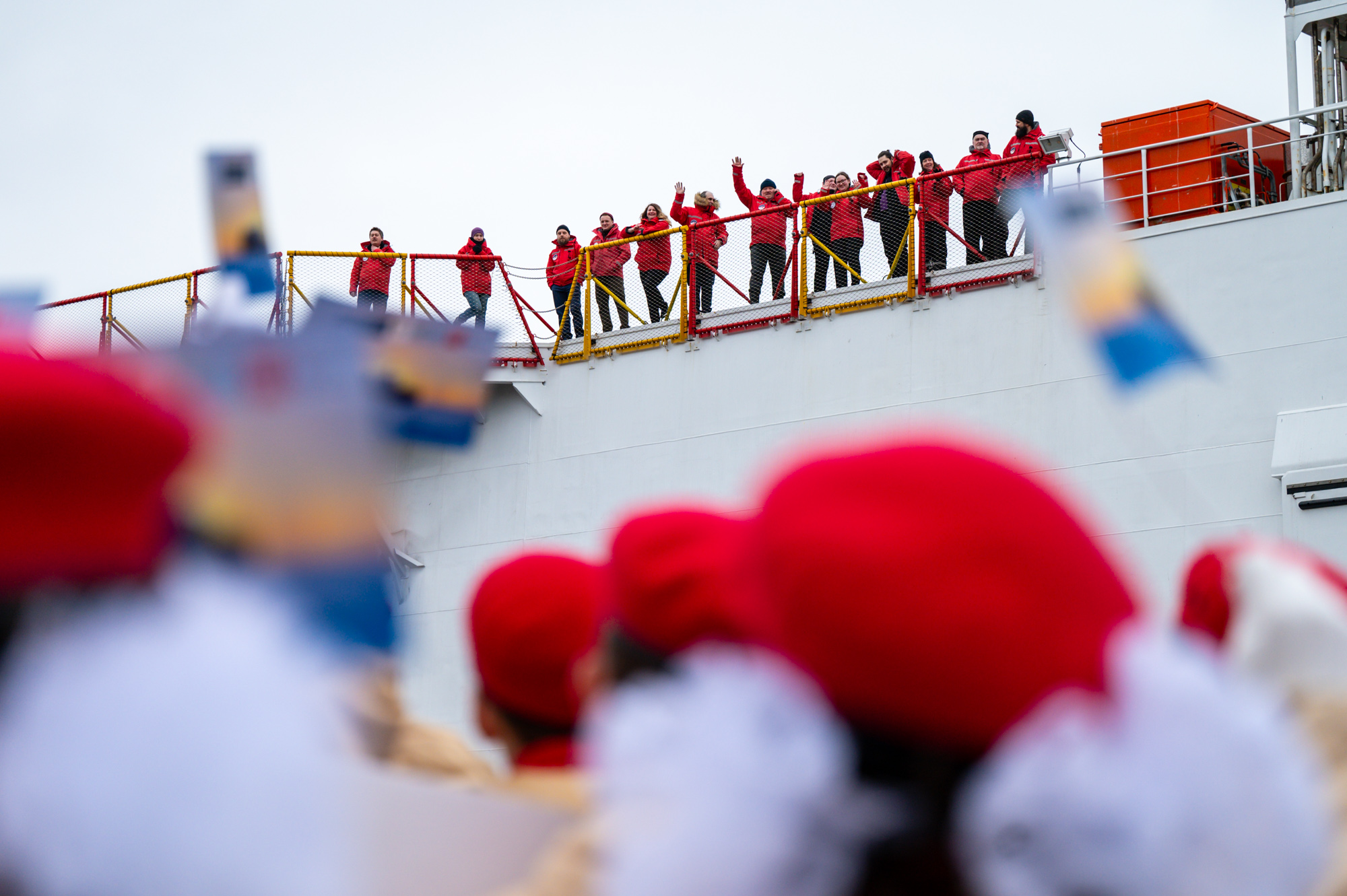The ice-resistant self-propelled platform "North Pole" was met in the Murmansk region after its first Arctic voyage

Polar explorers arrived at the port of the polar capital Murmansk after 20 months of work in the high latitudes of the Arctic Ocean. The team of scientists successfully completed scientific research, collecting unique data on the natural environment of the Arctic. At the pier of the fishing port, the platform crew was met by active youth with flowers and flags, an orchestra, First Deputy Governor of the Murmansk Region Oksana Demchenko, Director of the Arctic and Antarctic Research Institute, Head of the Murmansk Department of Hydrometeorology and Environmental Monitoring. The participants of the unique voyage were greeted via video link from the screen of the street stage by the Minister of Natural Resources and Environment of Russia Alexander Kozlov and the head of Roshydromet Igor Shumakov.
"With the start of work of the ice-resistant self-propelled platform, Russia has received the opportunity to conduct long-term scientific experiments at high latitudes. Scientists have access to 50 types of research: from meteorological to geophysical, glaciological, seismic and aerological. Their data will form the basis for understanding climate change and forecasting it, developing adaptation measures, and are important for ensuring the safety of navigation along the Northern Sea Route. The drifting station programs no longer depend on the unpredictability of ice - the launch of the North Pole-42 expedition is scheduled for September. This means that the world is waiting for new great discoveries," commented Minister of Natural Resources and Environment Alexander Kozlov.
Having started near the New Siberian Islands, the North Pole-41 drifting station covered more than 3,000 nautical miles, passing through the polar region towards the North European basin of the Atlantic Ocean. After entering ice-free waters, the North Pole R/V LSP with a team of scientists and polar explorers on board returned to Murmansk.
Oksana Demchenko greeted the team of scientists, which she saw off from the Murmansk pier in September 2022, noting that she feels pride and admiration for Russian researchers and developers of the unique platform. In the 20 months since the start of the North Pole-41 station, the general drift from the starting point in the New Siberian Islands area has amounted to more than 900 nautical miles. During the period of the station's operation, a program of 50 areas of interdisciplinary scientific research has been completed, including the study of the natural components of the Arctic region from the bottom of the Arctic Ocean to the stratosphere.
"The expedition allowed us to continue the history of the North Pole drifting stations, which began back in 1937 by the Papanin heroes. The use of a unique ice-resistant self-propelled platform made it possible to conduct the expedition at the highest professional level and ensured maximum safety of the work. In 20 months, the expedition covered three thousand nautical miles from the New Siberian Islands to the Spitsbergen archipelago, and unique data on the nature of the Arctic region were obtained, which will make a huge contribution to the study of its climate. I am confident that this important work will be continued within the framework of the next North Pole expeditions," said Igor Shumakov, head of Roshydromet, in his welcoming speech.
The North Pole-41 expedition was a continuation of the domestic program of drifting polar stations, which had to be curtailed in 2013 due to the melting of ice in the Arctic. AARI specialists analyzed and summarized the unique experience of previous expeditions and found the best option for long-term basing of research laboratories - the ice self-propelled platform "North Pole". The vessel, which has no analogues in the world, was built at the Admiralty Shipyards and launched in 2022. For polar explorers, it became transport, home, research center and even a measuring device - sensors are built into the LSP hull that will help study the ice situation.
The drifting station "North Pole-41" was opened on October 2, 2022, at a point with coordinates 82 ° 37 'N 155 ° 31' E. The ice-resistant self-propelled platform was moored to the edge of an ice field with an area of about 42 square kilometers, scientific equipment, transport and machinery were unloaded onto the ice. Scientists deployed field research laboratories. In April 2023, the first rotation of the station's expedition crew took place. The polar explorers were replaced on the ice 200 kilometers from the North Pole. The airfield at the Mys Baranova Ice Base research station on Severnaya Zemlya and the Barneo ice camp were used to deliver the scientists. In August 2023, the Akademik Tryoshnikov research vessel delivered food and new equipment to the polar explorers, as well as crew members to replace the ship's crew. During the same period, the platform re-moored to a new, more resistant to destruction ice field.
"Our polar explorers are real heroes! They work in the harshest and most dangerous corners of the planet. The scientists spent many months far from home, surrounded by ice and ocean, performing the most difficult scientific tasks. But the success of the entire operation is the combined result of the coordinated work of many people, including shipbuilders, designers, sailors, and scientists. Almost ten years have passed from the idea to its implementation, and today, on the eve of Polar Explorer Day, we are celebrating a grand victory!” said Alexander Makarov, Director of the Arctic and Antarctic Research Institute.
For reference:
The R/V LSP North Pole is a unique research and expedition vessel with the functionality of a research center and intended for year-round expeditions in the high latitudes of the Arctic Ocean. The vessel is designed to conduct geological, acoustic, geophysical and oceanographic research; it is capable of passing through ice without an icebreaker, and also accepting heavy helicopters such as the Mi-8 AMT (Mi-17) on board. The LSP will provide comfortable and safe working and living conditions for 14 crew members and 34 scientific personnel at temperatures down to -50° and humidity of 85%. The main tactical and technical characteristics of the LSP: length - 83.1 m; width - 22.5 m; displacement - about 10,390 tons; power of the propulsion plant - 4,200 kW; speed - not less than 10 knots; hull strength - Arc8; autonomy in fuel reserves - about 2 years; service life – at least 25 years.
The North Pole-41 (SP-41) expedition was a continuation of the program of comprehensive drifting research in the high latitudes of the Arctic, founded by Soviet scientists. The world's first polar research drifting Arctic station, the North Pole (North Pole-1), began work on May 21, 1937. Since then, each subsequent expedition has been given the name "North Pole" and a serial number. A total of 40 such expeditions were organized. For 75 years, drifting stations carried out comprehensive research in the field of oceanography, meteorology and marine biology, monitored the dynamics of changes in ice area, and made observations in the ionospheric and magnetic fields of the planet, allowing conclusions to be drawn about the propagation of radio waves. In 2013, the team of scientists from the drifting station "SP-40" was evacuated, the program was suspended for almost 10 years: the critical state of the ice, shifts, cracks, breaks did not leave the ice camp. In 2022, 85 years after its formation, the drifting Arctic station program was resumed at a technologically new level - the expedition is carried out with the support of the ice-resistant platform "North Pole".
/ Ministry of Information Policy of the Murmansk Region /












 Investment portal of Murmansk region
Investment portal of Murmansk region Investment map of Murmansk region
Investment map of Murmansk region
 Agency of Strategic Initiatives
Agency of Strategic Initiatives Мойбизнес.рф
Мойбизнес.рф  Development center of
Development center of  Murmansk city Administration
Murmansk city Administration Investment portal of Arctic zone
Investment portal of Arctic zone Rosinfra
Rosinfra